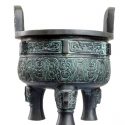Warning: this post is pure, unadulterated gleeful Yeekery.
I’ve been reading about how the ancient Chinese bronze vessels were made. Here’s a fascinating pdf on the subject (right click and choose ‘save as’ to download), with images of the finished vessels and also the moulds used in the casting, and diagrams showing the whole process. (It also explains the different ways legs were attached, casting light on 50.4.)
The ancient vessels were created with the piece mould process. To begin, you create a clay model of your vessel. After hardening the model, you cover it with soft clay to create a reverse image of it – with all the intricate decorations and patterning of its surface now in reverse relief. And you fire this as your pottery mould, which you’ll split carefully into three or four pieces that join together smoothly. Then you pare down the model, just enough to create a space between it and the outer mould. You put the two together, inserting little space-holders, bind it with bamboo or rope and bury it, and then pour in the molten bronze.
So… you create the shape of your Vessel…
![]()
(hexagram 50, ding, the Vessel)
And you create its perfect reverse image, with every feature in relief, every solid part corresponding with a space and vice versa…
![]()
(hexagram 3, Sprouting)
And then you open up enough space between them to pour in the molten metal. And here is the interesting thing… every hexagram between 3 and 50 finds its own complement, its own ‘reverse image’ hexagram, somewhere in that space. Then from hexagrams 51-64, every hexagram finds its complement within that much smaller space.
So… you could imagine the space between 3 and 50 as the space where the Vessel is cast, between the model and the mould. Then the outermost layers of the bronze would be hexagrams 4 and 49 – inverse pairs of 3 and 50, so naturally also one another’s complements. The next layer will be made of hexagrams 5 and 6 on one side facing hexagrams 48 and 47 on the other side, and so on all the way in until the hexagrams meet ‘in the middle’, mid-way between 3 and 50.
Let’s see how that looks – and I’ll draw the hexagram shapes side-on as I go along, because that’s the easiest way to represent an inverse pair:
3-4 face 50-49 |:::|: :|||:|
– complementary pairs.
5-6 face 48-47 |||:|: :||:|:
…oh, look… those hexagrams only differ by one line, the first or sixth (5.1 to 48, 6.6 to 47), the outside edge of the hexagram.
7-8 face 46-45 :|:::: :||:::
Hm… these also differ by one line, now lines 3 and 4: the inner ‘edges’ of a hexagram, at the threshold between trigrams.
9-10 face 44-43 |||:|| :|||||
This time the trigrams have swapped places, moving the yin line from position 3/4 to position 1/6.
11-12 face 41-42 |||::: ||:::|
Quoting from Wilhelm/Baynes page 596:
“Peace and Standstill have an inner connection with Decrease and Increase, because through the transference of a strong line from the lower to the upper trigram, Decrease develops from Peace, and through the transference of a strong line from the upper to the lower trigram, Decrease develops from Standstill.”
As you can imagine, by now my inner Yeek was dancing round the room. She gets like that. Only… what happens next?
13-14 : 40-39 |:|||| :|:|::
15-16 : 38-37 ::|::: ||:|:|
17-18 : 36-35 |::||: |:|:::
Err… the inner trigrams are complements of 13/40 and 15/38 are complements? There are lots of animals in 15, 16, and 38? We start with fire and heaven and end up with fire and earth, creating a sort of set?
I seem to recognise the hollow sound of a barrel being scraped.
But wait!
19-20 : 34-33 ||:::: ||||:: – complements!
And then?
21-22 : 32-31 |::|:| :|||::
23-24 : 30-29 :::::| |:||:| :|::|:
25-26: 28-27 |::||| |::::| :||||:
And that, of course, is the centre of the space between 3 and 50. It just happens to fall at hexagrams 27 and 28,
– whose shape and transformation into one another is uncannily reminiscent of moulds and casting. And this faces hexagrams with themes of detaching and bonding and of joining with the power of heaven. And then the next facing ‘pair of pairs’ shows earth and a cutting action alongside images of shining fire and the apex of culture paired with water and pits dug in the earth.
Incidentally, at the end of the whole sequence we have 61-62, also mould-and-metal shaped, and then 63-64, what Scott Davis calls ‘burning water’. There are three complementary, reverse-relief pairs left after hexagram 50: 53-54, 61-62, 63-64. The three legs would generally be cast separately and incorporated into the piece mould to join with the molten metal. OK, perhaps now I’m pushing it a bit again…
So what do you think? Is this a real pattern? I know it melts away to nothing as you get towards the centre… but then wouldn’t you expect the metal at the centre to cool more slowly and be more mixed, while the shape of the mould is clearer towards the outer surfaces?

